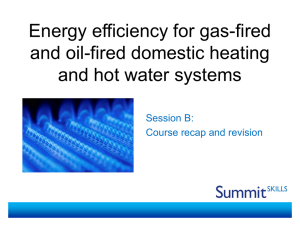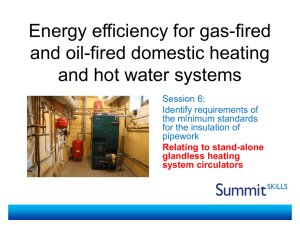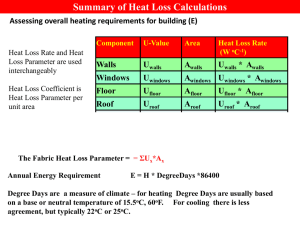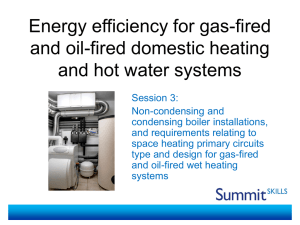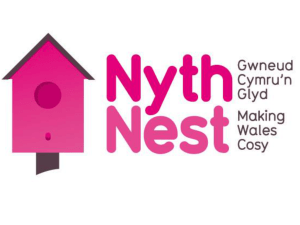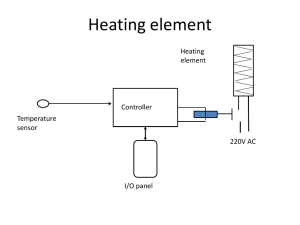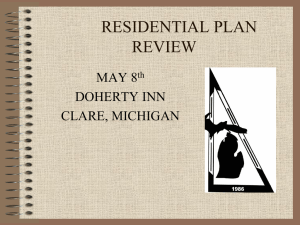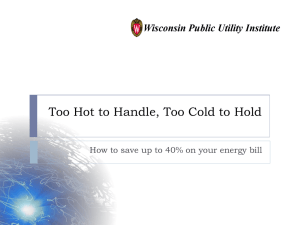Welcome to Energy efficiency for gas-fired and oil
advertisement
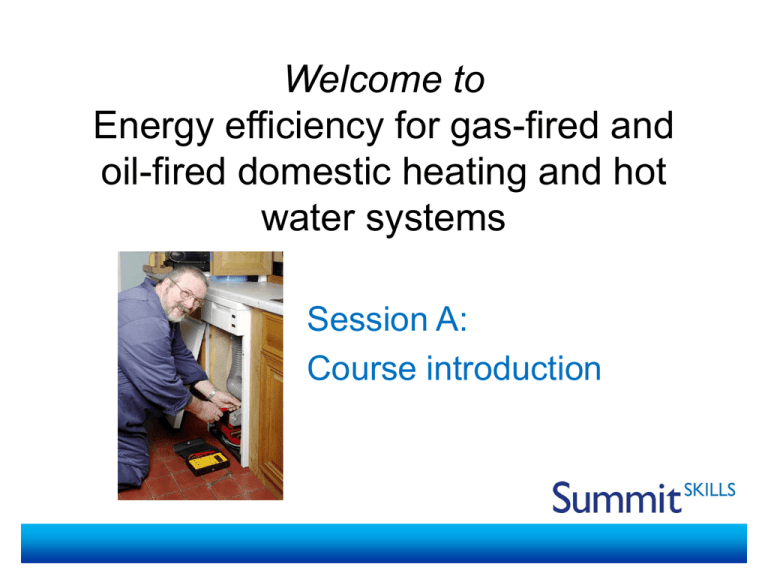
Welcome to Energy efficiency for gas-fired and oil-fired domestic heating and hot water systems Session A: Course introduction Energy efficiency for gas-fired and oil-fired domestic heating and hot water systems Session A – course introduction Session objectives • • • • • • Introduce you to the college Ensure all registration paperwork is complete Confirm key information including health and safety rules Get to know each other Outline the course Answer any initial questions Energy efficiency for gas-fired and oil-fired domestic heating and hot water systems Session A – course introduction Session activities • • • • • • Register, welcome and introductions Tour of key site locations Icebreaker activity Briefing on course timetable Self assessment exercise Discussion Energy efficiency for gas-fired and oil-fired domestic heating and hot water systems Session A – course introduction Icebreaker Please discuss in groups the following questions: • What is your sector background? • What is the most memorable experience of your working life? • What are your expectations of the course and how do you think it might help you in your current and/or future work? • What is an interesting fact about yourself ? At the end of this activity you will be asked to share with the group an interesting fact about another student, their sector background and briefly state why you enrolled on the course and/or how you hope the course will help you. Energy efficiency for gas-fired and oil-fired domestic heating and hot water systems Session A – course introduction Course overview – topics covered After successfully completing this course you will: Know the regulatory requirements and sources of guidance for energy efficiency standards for gas-fired and oil-fired heating appliances connected to ‘wet’ heating circuits Know the requirements of minimum boiler efficiency standards for gas-fired and oil-fired heating appliances connected to ‘wet’ heating circuits Be able to determine if a non-condensing boiler installation would be acceptable Know the requirement relating to space heating primary circuits type and design for gas-fired and oilfired ‘wet’ heating systems Know the compliance standards requirement for hot water storage vessels Energy efficiency for gas-fired and oil-fired domestic heating and hot water systems Session A – course introduction Course overview – topics covered (continued) After successfully completing this course you will: • Know the requirements relating to the preparation and water treatment of hot water systems and wet central heating systems • Know the requirements relating to the commissioning of hot water systems and wet central heating systems • Know the requirements of the minimum standards for the control of gas-fired and oil-fired wet central heating systems • Know the requirements of the minimum standards for insulation of pipework for gas-fired and oil-fired wet central heating and hot water storage systems • Know the requirements relating to stand-alone, glandless heating systems circulators Energy efficiency for gas-fired and oil-fired domestic heating and hot water systems Session A – course introduction Course overview – summary of sessions This course is split into 9 sessions: • Today’s session, Session A, introduces you to the course. • Sessions 1 to 6 cover core learning. • Sessions B and C focus upon revision. • Session D is the final multiple choice assessment. To complete the course you are expected to attend every session, with every session giving valuable learning to help you in work and to prepare for the end of course assessment. Sessions will include a mix of activities including listening, research and self-assessment exercises. Energy efficiency for gas-fired and oil-fired domestic heating and hot water systems Session A – course introduction Course overview – core learning sessions Session 1 During this session you will research and discuss relevant: • regulatory requirements • efficiency standards for gas-fired and oil-fired heating appliances connected to ‘wet’ heating circuits Session 2 During this session you will research, discuss and complete calculations related to requirements for: • gas-fired heating appliances connected to ‘wet’ heating circuits • oil-fired heating appliances connected to ‘wet’ heating circuits Session 3 During this session you will research, discuss and complete calculations related to requirements for: • non condensing boiler • space heating primary circuits type and design for gas-fired and oil-fired ‘wet’ heating systems Energy efficiency for gas-fired and oil-fired domestic heating and hot water systems Session A – course introduction Course overview – core learning sessions (continued) Session 4 During this session you will research and discuss requirements for: • hot water storage vessels • preparation and water treatment of hot water systems and wet central heating systems • commissioning of hot water systems and wet central heating systems Session 5 During this session you will research and discuss requirements for: • the control of gas-fired and oil-fired wet central heating systems Session 6 During this session you will research, discuss and complete calculations related to requirements for: • insulation of pipework for gas-fired and oil-fired wet central heating and hot water storage systems • glandless heating systems circulators Energy efficiency for gas-fired and oil-fired domestic heating and hot water systems Session A – course introduction Course overview – revision and assessment The course will finish with a multiple choice assessment. To prepare you for this session two essential interactive revision focused sessions will reflect on your learning throughout the course and help you to assess and address areas of knowledge and types of calculations that you need particular help with. Session B This session will: • explain the purpose and structure of the end of course assessment • review core learning from all course sessions Session C This session will include practice multiple choice questions and further revision. Session D The end of course assessment will be completed during this session. Energy efficiency for gas-fired and oil-fired domestic heating and hot water systems Session A – course introduction Self assessment exercise Students should work individually to complete the self assessment exercise. Answers are shown on the following slides. The purpose of this activity is to help you and your tutor see what knowledge you have at the start of the course. It is expected that students will be starting with a range of knowledge. Energy efficiency for gas-fired and oil-fired domestic heating and hot water systems Session A – course introduction Solutions Question 1 Solar, heat pumps and biomass are the 3 renewable technologies most commonly used in UK domestic heating and water (in 2013). Questions 2 and 3 It is expected that students will be starting with a range of experience, qualifications and training and may learn from each other through informal and formal discussions as you progress through the course. Energy efficiency for gas-fired and oil-fired domestic heating and hot water systems Session A – course introduction Solutions Question 4 If you replace a conventional gas fired boiler in a domestic style property built since 1 April 2005 you would normally install a condensing boiler. Question 5 You would not usually install an immersion heater in a house with a combination boiler, although a separate hot water storage tank and immersion may be installed in certain circumstances e.g. with solar water heating. Energy efficiency for gas-fired and oil-fired domestic heating and hot water systems Session A – course introduction Solutions Question 6 An oil boiler should be maintained by somehow who is OFTEC registered. Question 7 In dwellings with a total usable floor area up to 150m2 should be divided into at least two space heating zones with independent temperature control, one of which is assigned to the living area Energy efficiency for gas-fired and oil-fired domestic heating and hot water systems Session A – course introduction Solutions Question 8 Vented copper hot water cylinders should comply with BS 1566: 2002 part 1. Question 9 According to the “Domestic Building Services Compliance Guide” an oil combination boiler installed in a new dwelling should have an (2009 SEDBUK) efficiency not less than 88%. Question 10 A boiler interlock can improve efficiency by preventing the pump from running and the boiler from firing when there is no demand for heating or hot water. Energy efficiency for gas-fired and oil-fired domestic heating and hot water systems Session A – course introduction Solutions Question 11 An acceptable position for a boiler terminal according to the “Guide to condensing boiler assessment procedure for dwellings” would be a flue terminal (not a vertical flue pipe) visible from the front of the building. The following would not be acceptable positions for a boiler terminal: • A wall terminal that discharges under the roof of a car port • A wall terminal less than 2.1m above the ground that discharges across a public footpath • A flue that passes through another dwelling, another building in different ownership or another fire compartment Energy efficiency for gas-fired and oil-fired domestic heating and hot water systems Session A – course introduction Solutions Question 12 New gas of oil fired heating and hot water systems should be fully pumped. Replacement gas or oil fired heating and hot water systems should be fully pumped. The system should be converted to fully pumped when replacing gas or oil fired heating boilers. Energy efficiency for gas-fired and oil-fired domestic heating and hot water systems Next Session: regulatory requirements and efficiency standards for gas-fired and oil-fired heating appliances connected to ‘wet’ heating circuits During the session you will: Become familiar with using college computers to conduct online research Learn where to find regulatory requirements and sources of guidance for energy efficiency standards for gas-fired and oilfired heating appliances connected to ‘wet’ heating circuits Become familiar with regulatory requirements and sources of guidance for energy efficiency standards for gas-fired and oilfired heating appliances connected to ‘wet’ heating circuits Report back to the group on the websites and information you find
